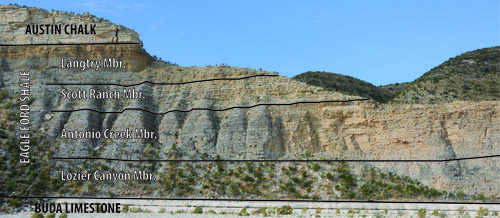Controls on the Development of Anoxia
in the Cretaceous Western Interior Seaway, USA
By:
Chris Lowery
UTIG
Click for a Live Broadcast.

Abstract
The Cretaceous Period (145-66 Ma) was a time of elevated global temperatures superimposed on fluctuating climate regimes and repeated biotic turnover. It recorded several major perturbations of the carbon cycle, characterized by widespread deposition of organic-rich black shale and benthic and photic zone dysoxia to euxinia, termed oceanic anoxic events (OAEs). The last two of OAEs, the Cenomanian-Turonian OAE2 and the Coniacian-Santonian OAE3 are well-preserved in the Western Interior Sea (WIS) of North America.
The expression of these OAEs in the WIS differs both from each other and from contemporaneous open-ocean sections. Despite decades of research, questions remain about the role of oceanographic parameters (sea level, water mass source and character, terrestrial runoff, stratification, productivity, circulation) on the development (or not) of organic-rich shales and anoxic to dysoxic conditions in the WIS. This study utilizes the paleoecology of planktic and benthic foraminifera (marine protists with a hard shell, or "test," that is commonly preserved in the geologic record) and bulk rock geochemical data to address the broad question "How did oceanographic changes effect the development of OAEs in the Western Interior?"
A transect of sites in the Eagle Ford Shale of Texas is used to understand the connection between the well-studied OAE2 interval of the WIS (Greenhorn Formation) and the open ocean, which appears to have been controlled by a sill at the SE aperture of the WIS that was overcome by rising sea level in the late Cenomanian, ventilating the sea. The poorly understood development of OAE3 in the central Western Interior is studied in the Niobrara Formation in Colorado, Kansas, and New Mexico and equivalent rocks further west. Foraminiferal trends through this interval show a slow increase in dysoxia prior to the "onset" of OAE3 recorded by other proxies. Above this level, benthic foraminifera disappear and a stressed planktic assemblage remains unchanged for ~3 million years. This suggests a threshold for anoxia that, once exceeded, pushed the WIS into a new equilibrium. Trends observed during OAEs suggest that sea level change is the principle control on the redox state of the sea: transgressions are associated with continually improving oxygenation due to increasing ventilation of the sea, and regressions are associated with deteriorating oxygenation and the deposition of organic carbon due to greater stratification.




